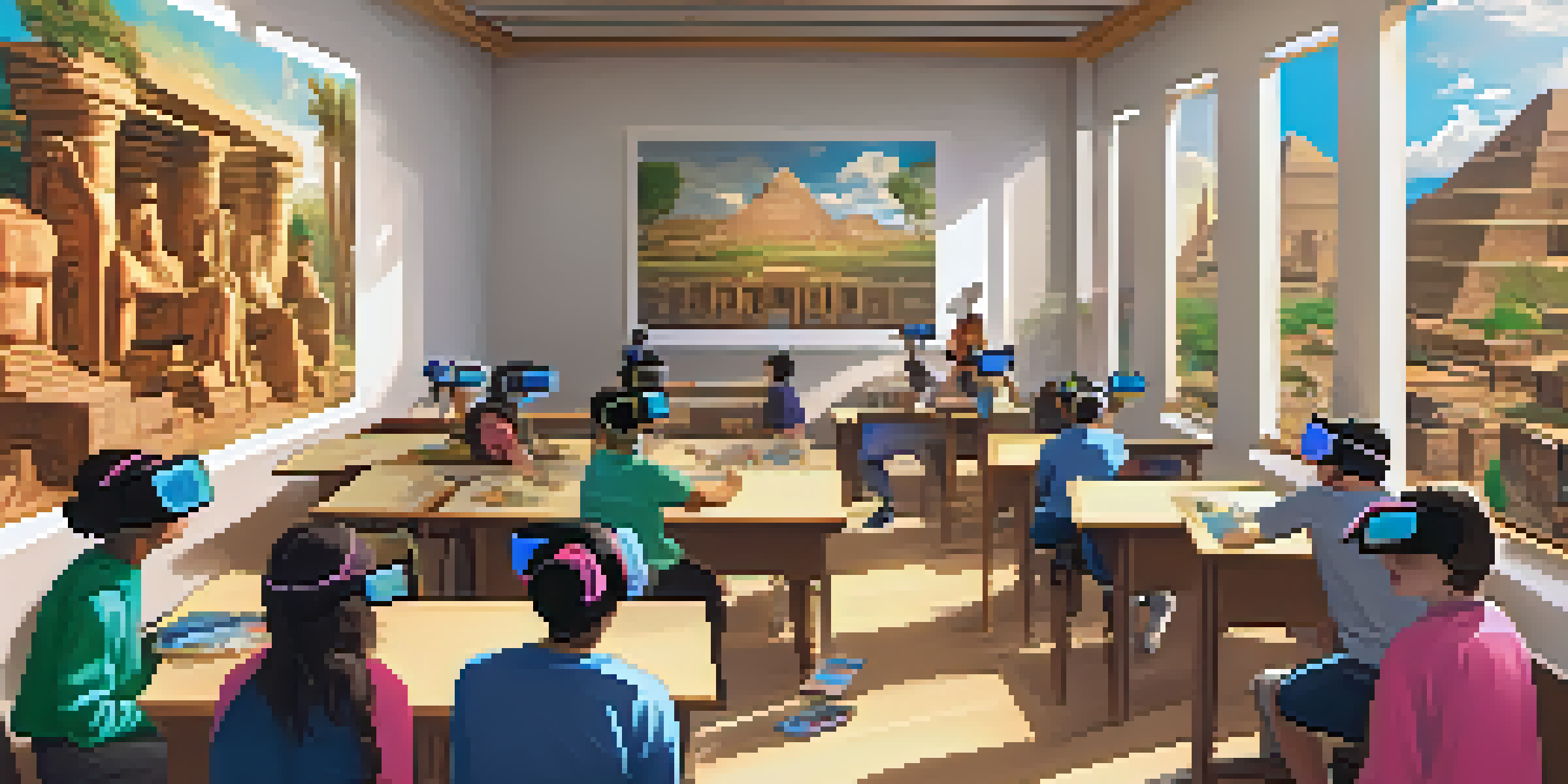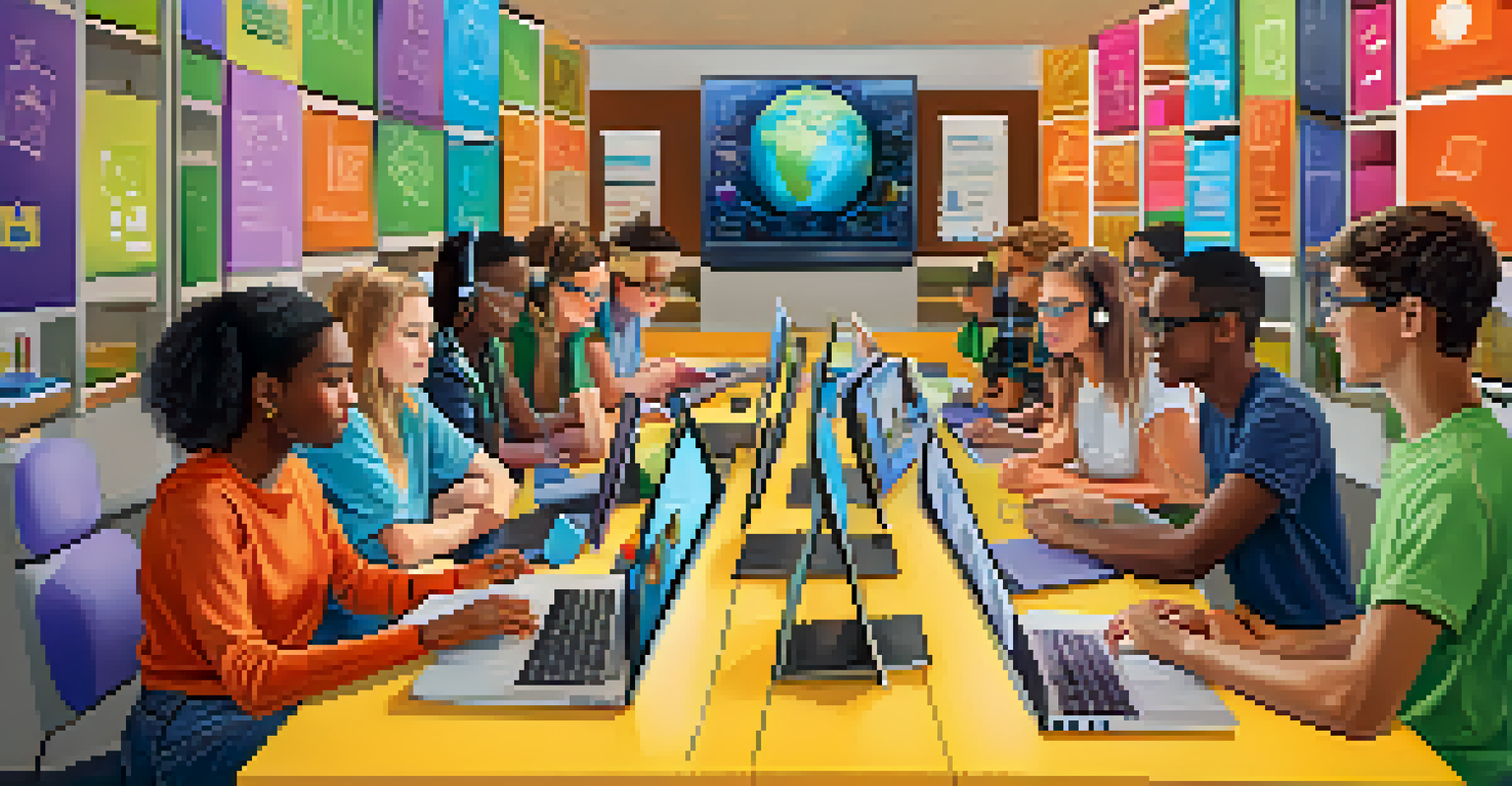Exploring the Use of Virtual Reality in LMS Platforms

Understanding Virtual Reality and LMS Integration
Virtual Reality (VR) immerses users in a 3D environment, offering experiences that traditional learning methods simply can’t match. When integrated with Learning Management Systems (LMS), VR can transform how we approach education. Picture a classroom where students can explore ancient civilizations or conduct complex science experiments without leaving their seats.
The future of education is not just about technology; it's about creating connections between learners and experiences that enrich their understanding.
The synergy between VR and LMS platforms creates a dynamic learning experience, making lessons more engaging and interactive. This integration allows learners to visualize concepts that might otherwise be abstract or difficult to grasp. For instance, a medical student can practice surgeries in a risk-free VR setting before operating on real patients.
As we delve deeper into this topic, we'll explore specific applications and the benefits they bring to various learning environments. Understanding this integration is crucial for educators looking to enhance their teaching strategies. So, let’s take a closer look at how VR enriches the LMS landscape.
Benefits of Virtual Reality in Learning Management Systems
One of the standout benefits of using VR in LMS is the heightened engagement it fosters among learners. When students interact with content in an immersive environment, they often retain information better and show increased motivation to learn. Imagine a student excitedly participating in a virtual field trip to Mars instead of reading about it in a textbook.

Additionally, VR can cater to different learning styles, whether visual, auditory, or kinesthetic. This adaptability ensures that all learners can find a method that resonates with them, enhancing overall comprehension. For instance, a visual learner might thrive in a 3D anatomy lesson, while a kinesthetic learner benefits from interactive simulations.
VR Enhances Engagement in Learning
Integrating Virtual Reality into Learning Management Systems significantly boosts student engagement and information retention.
Moreover, the ability to simulate real-world scenarios in a controlled environment prepares students for practical application of their knowledge. This approach is especially beneficial in fields like healthcare, engineering, and environmental science. As we see, the advantages of VR in LMS are not just theoretical; they have practical implications that can elevate education.
Current Applications of VR in LMS Platforms
Today, many educational institutions are implementing VR technology within their LMS to create unique learning experiences. For example, platforms like Google Expeditions allow students to take virtual field trips around the globe, from the depths of the ocean to the surface of the moon. This kind of immersive exploration enriches the curriculum and makes learning more meaningful.
Virtual reality is a new way of learning, where the boundaries of time and space are removed, allowing students to engage with their subjects in profound new ways.
Another application is in the realm of corporate training, where companies use VR simulations for onboarding and skills development. Employees can practice customer interactions or complex machinery operations in a safe, virtual environment. This hands-on experience often leads to better performance in real-world situations.
Furthermore, VR can facilitate collaborative learning, where students from different locations come together in a virtual space to work on projects. This not only promotes teamwork but also prepares students for the increasingly globalized workplace. Thus, the current applications of VR in LMS are diverse and impactful.
Challenges in Implementing VR in LMS
Despite its many benefits, integrating VR into LMS platforms does come with challenges. One major hurdle is the cost of VR technology, which can be prohibitively expensive for some educational institutions. Schools and organizations must weigh the investment against potential returns in learning outcomes.
Another challenge is ensuring that both educators and students are adequately trained to use VR tools effectively. Without proper training, the potential of VR can be underutilized, leading to frustration and disengagement. Institutions need to provide resources and support to ensure everyone is comfortable with the technology.
Applications of VR in Education
Educational institutions are utilizing VR for immersive experiences, ranging from virtual field trips to corporate training simulations.
Additionally, there are concerns regarding accessibility for all learners. Not every student has the same level of access to VR equipment, which can create disparities in learning experiences. Addressing these challenges is essential to fully realize the potential of VR in LMS.
The Role of Educators in VR Learning Environments
Educators play a pivotal role in the successful integration of VR within LMS platforms. They are not just facilitators of knowledge; they also need to become adept at using VR tools to enhance their teaching methods. This requires ongoing professional development and a willingness to experiment with innovative approaches.
Moreover, educators should be proactive in designing VR experiences that align with learning objectives. This means creating immersive lessons that not only captivate students but also ensure they meet curriculum standards. For instance, a history teacher could create a VR experience that allows students to walk through significant historical events.
Ultimately, the success of VR in education hinges on the collaboration between educators, technology providers, and learners. By working together, they can create engaging and effective learning experiences that harness the power of VR. So, the role of educators is crucial in making this technology a valuable asset in the classroom.
Future Trends in Virtual Reality and LMS
As technology continues to evolve, the future of VR in LMS looks promising. We can expect advancements in VR hardware and software that will make these tools more accessible and user-friendly. This could lead to broader adoption of VR in educational settings, expanding its reach to more students.
Moreover, the integration of artificial intelligence (AI) with VR could personalize learning experiences even further. AI can analyze a learner's progress and adapt VR content to suit their individual needs, providing tailored educational experiences. Imagine a VR lesson that adjusts in real-time to challenge or support a student based on their performance.
Challenges in VR Implementation
Despite its benefits, the integration of VR in LMS faces challenges such as cost, training, and accessibility for all learners.
Additionally, the rise of remote and hybrid learning models may drive the demand for VR experiences that foster connection among students. As more learners engage from various locations, VR can bridge the gap, creating a sense of community in education. These future trends indicate that VR will play an increasingly integral role in LMS.
Conclusion: Embracing Virtual Reality in Education
In conclusion, the integration of Virtual Reality in Learning Management Systems represents a significant leap forward in educational practices. By providing immersive and interactive experiences, VR fosters engagement and enhances understanding. As we’ve explored, the benefits are numerous, from catering to different learning styles to preparing students for real-world applications.
However, the challenges of implementing VR must not be overlooked. It’s essential for educators and institutions to address issues of cost, training, and accessibility to ensure that all learners can benefit from this technology. Collaboration and innovation will be key in overcoming these hurdles.

As we move forward, embracing VR in education can open up a world of possibilities, making learning not just informative but also exciting. The future of education is bright, and Virtual Reality is poised to play a central role in shaping it.